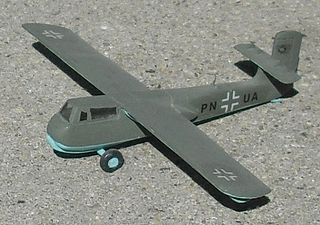
The Blohm & Voss BV 40 was a German glider fighter designed to attack Allied bomber formations during the time of the bombing raids over Nazi Germany.

The Airspeed AS.51 Horsa was a British troop-carrying glider used during the Second World War. It was developed and manufactured by Airspeed Limited, alongside various subcontractors; the type was named after Horsa, the legendary 5th-century conqueror of southern Britain.

The Antonov A-40 Krylya Tanka was a Soviet attempt to allow a tank to glide onto a battlefield after being towed aloft by an airplane, to support airborne forces or partisans. A prototype was built and tested in 1942, but was found to be unworkable. This vehicle is sometimes called the A-40T or KT.

Tanks with glider wings were the subject of several unsuccessful experiments in the 20th century. It was intended that these could be towed behind, or carried under, an airplane, to glide into a battlefield, in support of infantry forces.

The Baynes Bat was an experimental glider of the Second World War, designed by L. E. Baynes. It was used to test the tailless design that he had suggested as a means to convert tanks into temporary gliders so they could be flown into battle.

The Antonov A-7 was a Soviet light troop military glider of World War II.
The Maeda Ku-1, long designation Maeda Army Type 2 Small Glider, was a small twin boom Japanese military glider. It was primarily used for training, and was superseded by the Kokusai Ku-7, which was effectively a scaled-up version of the design. Approximately 100 were produced.

The Kokusai Ku-7 Manazuru was a large experimental twin boom Japanese military glider.

The Kokusai Ku-8-II was a Japanese military glider used during the Second World War.

The Waco CG-13 was an American military transport glider aircraft developed during World War II.
The de Havilland Australia DHA-G2 was a Second World War Australian transport glider based on the earlier prototype DHA-G1. Only two prototype G1 and six production G2 gliders were built.
The Hindustan Aircraft G-1 was a Second World War Indian transport glider, the first design of Hindustan Aircraft Limited, only one glider was built.
The Christopher AG-1 was a proposed Second World War American assault glider part of a United States Army assault glider project, none were built and the programme was cancelled in September 1943.
The Timm AG-2 was a proposed Second World War American assault glider part of a United States Army assault glider project, none were built and the programme was cancelled in September 1943.
The Bowlus CG-8 was a prototype Second World War American transport glider to be built for United States Army, one was built but the type did not enter production and the programme was cancelled.
The Bowlus CG-7 was a prototype Second World War American transport glider to be built for United States Army, one was built but the type did not enter production and the programme was cancelled.

The Aeronautica Lombarda AL-12P was a Second World War Italian transport glider built by the Aeronautica Lombarda for the Italian Army.

The Special number 3 light tank Ku-Ro was an experimental Japanese winged light tank project, developed during World War II.
The Nihon Kogata Ku-11 was a 1940s experimental Japanese military glider. The Ku-11 was an all-wood high-wing transport glider with two crew and room for 12 fully equipped troops. With little interest from the Imperial Japanese Army the type did not enter production.
The BDP S-1 was a military glider of the Soviet Union. It was produced by the Bureau of Special Construction in 1941 as a glider infantry troop transport. It accommodated 20 troops plus one pilot, and had gun ports for defense. Of wooden construction, the glider featured a high aspect ratio, high-cantilever wing and trailing flaps, utilizing a wheeled-carriage for takeoff and landing on plywood runners Due to the advance of German forces, only seven were built until the factory was moved, and production was shifted to powered aircraft.









